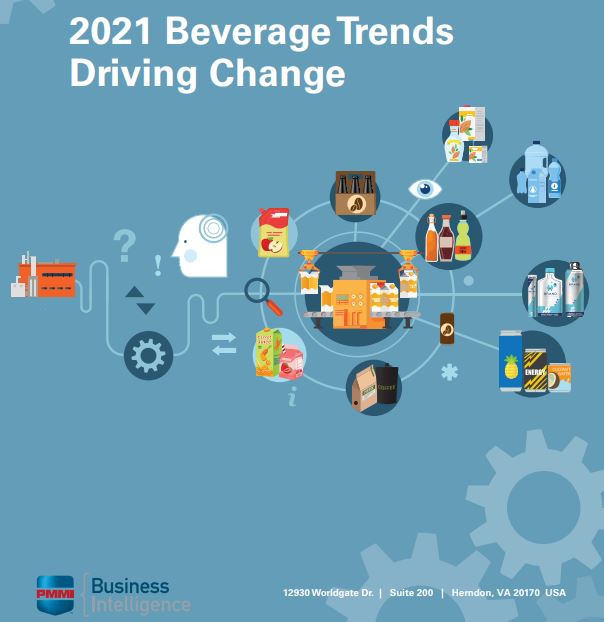
In a new Business Intelligence Report from PMMI titled 2021 Beverage Trends Driving Change, beverage manufacturers discuss the operational challenges the industry faces to meet consumer demands, adapting to changes due to material supply shortages, and why IIOT (Industrial Internet of Things) automation and robotics implementations are advancing at record levels. The report covers a broad range of beverages, including water, juice, soft drinks, energy and sports drinks, coffee, tea, and new functional drinks (alcoholic and dairy drinks were excluded in all findings). Consumer demands are driving change in a variety of areas in the supply chain, and we give just a few highlights of the report below.
It’s no surprise that consumers are looking for sustainable packaging options and are willing to pay more for them. For beverage companies, this means less use of plastic and more use of recycled bottles and cans. The use of recycled material for bottles has its own packaging inconveniences and with aluminum shortages, the challenge of finding beverage cans can be significant on its own. Consumers are looking for healthier drink choices and functional beverages that have less sugar, contain clean ingredients, and have better nutritional information such as vitamins and minerals. For beverage producers, this may require a change in drink formulas and recipes and perhaps expanded SKUs. There is also an increased demand for convenient sizing, translating to a need for a variety of packaging sizes and equipment that can handle a range of product sizes. The COVID-19 pandemic put a greater focus on product safety and drastically increased e-commerce and direct-to-consumer orders.
This change in demand has forced companies to look inward for ways to innovate and stay ahead of the curve on taste preferences. From formulas and recipes down to packaging and shipping- one decision can have an impact all along the supply chain. To keep up with demand, beverage manufacturers are relying heavily on automation technology as well as digitization techniques that allow them to streamline operations while also improving overall equipment effectiveness.
All these changes have greatly affected the packaging line. Companies in the market for new or upgraded equipment are looking for machines that meet crucial criteria. For example, equipment needs to be flexible. If a beverage company has a large number of SKUs and products packaged in a range of sizes and packaging material, machines must be flexible enough to accommodate these changes with minimal changeover and downtime. Additionally, changes in beverage recipes require the filling of different flavors, syrups, and varying viscosities which are required to run through filling machines. The demand for ESL beverages increased during the pandemic due to their ability to maintain freshness without refrigeration and MAP capabilities if the product needs any form of preservation while being stored on store shelves. Machines also need to be equipped with smart automation and an emphasis on robotics is apparent. With a shortage of skilled labor and a need for zero human error, smart technology and robotics must provide efficient predictive and preventative maintenance. Digital intelligence is needed now more than ever.
The future of the packaging industry is an exciting one. And with changes in consumer demands, ripple effects across interconnected industries are inevitable. However, these shifts can help beverage companies stay ahead of the curve on what customers want today while keeping an eye out for what they will require tomorrow. It’s just the tip of the iceberg, but it’s one that will have a lasting impact. So, the next time you take a sip from a beverage with ingredients or packaging mentioned in this report, think of all that went into making that change!
Download the PMMI white paper below for a full report of information, consumer trends, and how these trends have shaped the packaging industry and will continue to shape us into 2022 and beyond.

